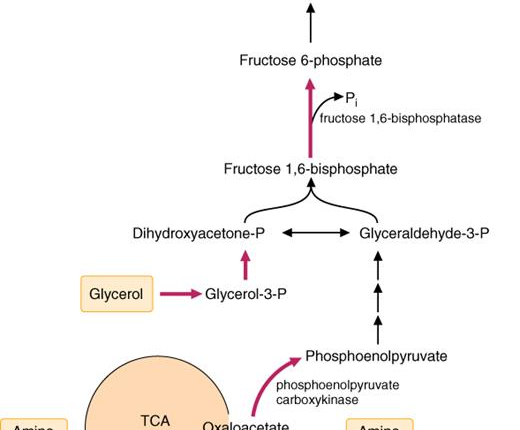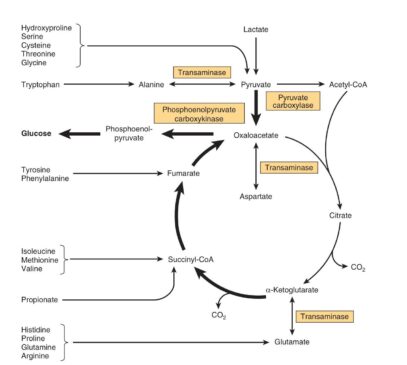Library
Gluconeogenesis: Pathways, Substrates, and Key Enzymes Explained with mnemonics
- October 29, 2024
- Posted by: Namrata Chhabra
- Category: Energy metabolism Learning resources Library Metabolism of Carbohydrates Quick Revision Series Quick revisions Quick revisions USMLE Content

Gluconeogenesis
Gluconeogenesis is a vital metabolic process that allows the body to synthesize glucose from non-carbohydrate sources, ensuring a continuous supply of glucose, especially during fasting or intense exercise. Below, we explore how key substrates enter gluconeogenesis and the role of specific enzymes with easy-to-remember mnemonics to simplify learning.

Figure 1: Gluconeogenesis and Its Connection with Glycolysis
This figure illustrates the key intermediates and pathways that connect glycolysis and gluconeogenesis. Glycerol, lactate, and amino acids enter at various points, with the TCA cycle playing a central role in regulating gluconeogenesis. Notably, alanine and lactate are converted into pyruvate, which serves as a key entry point, while oxaloacetate from the TCA cycle provides a critical intermediate for glucose production.

Figure 2: Amino Acid Entry into the TCA Cycle and Gluconeogenesis
This diagram details how different amino acids are funneled into the TCA cycle through intermediates like α-ketoglutarate, succinyl-CoA, and fumarate. These intermediates ultimately contribute to gluconeogenesis by forming oxaloacetate, which is converted into phosphoenolpyruvate (PEP) and eventually glucose.
Table: Substrates of Gluconeogenesis, Portal of Entry, Key Enzymes, and Mnemonics
| Substrate | Portal of Entry into Gluconeogenesis | Key Enzyme(s) | Mnemonic | Explanation |
| Alanine | Pyruvate | Alanine aminotransferase (ALT) | “Ala the Pyruvate Chef” | Alanine is converted to pyruvate by ALT, ready to “cook” glucose in gluconeogenesis. |
| Lactate | Pyruvate | Lactate dehydrogenase (LDH) | “Lactate to the Rescue” | Lactate is converted back to pyruvate under anaerobic conditions to sustain glucose production. |
| Glutamate / Glutamine | α-Ketoglutarate | Glutamate dehydrogenase, Transaminases | “Glutton for Keto” | Glutamate is converted to α-ketoglutarate, which enters the TCA cycle, eventually forming oxaloacetate. |
| Glycerol | Dihydroxyacetone phosphate (DHAP) | Glycerol kinase, Glycerol-3-phosphate dehydrogenase | “Glycerol Loves DHAP” | Glycerol from fat breakdown is converted to DHAP, feeding into gluconeogenesis. |
| Propionyl-CoA (from odd-chain fatty acids) | Succinyl-CoA → Oxaloacetate | Propionyl-CoA carboxylase, methylmalonyl-CoA mutase | “Prop to Succession” | Propionyl-CoA enters via succinyl-CoA and is converted to oxaloacetate. |
| Fructose (via Fructose-1-phosphate) | Glyceraldehyde-3-phosphate (G3P) | Aldolase B, Triose phosphate isomerase | “Fruity G3P” | Fructose is converted into G3P, feeding into gluconeogenesis. |
| Aspartate | Oxaloacetate | Aspartate aminotransferase (AST) | “Aspartame OXO” | Aspartate is converted to oxaloacetate, a key gluconeogenic intermediate. |
| Pyruvate | Oxaloacetate | Pyruvate carboxylase | “Pyro Makes OXO” | Pyruvate is converted to oxaloacetate by pyruvate carboxylase, starting gluconeogenesis. |
Key Mnemonics for Easy Recall:
“Ala the Pyruvate Chef” – Alanine is transformed into pyruvate, which is “cooked” into glucose through gluconeogenesis.
“Lactate to the Rescue” – During anaerobic conditions, lactate is recycled into pyruvate, ensuring continued glucose production.
“Glutton for Keto” – Glutamate feeds into α-ketoglutarate, which cycles through the TCA and contributes to oxaloacetate formation.
“Glycerol Loves DHAP” – Glycerol, derived from fat breakdown, becomes DHAP, a vital gluconeogenic intermediate.
“Prop to Succession” – Propionyl-CoA, an odd-chain fatty acid product, enters the TCA cycle through succinyl-CoA to produce oxaloacetate.
“Fruity G3P” – Fructose is converted to G3P, supporting gluconeogenesis.
“Aspartame OXO” – Aspartate transforms into oxaloacetate, which enters gluconeogenesis to produce glucose.
“Pyro Makes OXO” – Pyruvate is converted to oxaloacetate, a critical first step in glucose synthesis.
Conclusion
These two diagrams and the accompanying table highlight the intricacies of gluconeogenesis, showing how substrates like alanine, lactate, and glycerol enter through different pathways. The TCA cycle plays a crucial role by generating intermediates such as oxaloacetate, which drive glucose production. With these insights and mnemonics, students can better understand the key substrates and enzymes involved, simplifying the complex interplay between metabolism and glucose synthesis.
